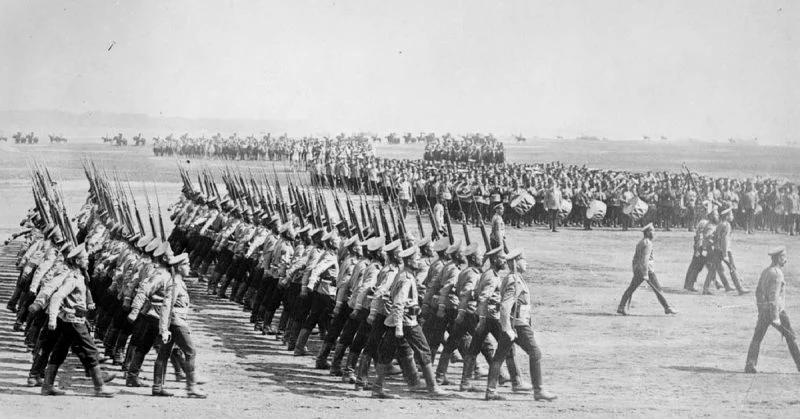A Quick Glance: The Russian Revolution | Five Minute Flashback
- ZTV Akron
- Apr 16, 2020
- 6 min read
General Manager: Juan Contreras
Producer: Nicole Maxhimer
Author: Collin Long
Hello and welcome, my name is Collin Long and due to circumstances surrounding the COVID-19 outbreak, all of our segments have transitioned to a written format. With that said, welcome to Five Minute Flashback, your encyclopedic compendium of thousands of years of world events told in the incredibly brief span of 5 minutes (or however long it takes for you to read this). And today I’ll be examining the fall of the last Tsarist regime in Russia to the rise of the first Communist state in the world. That’s right, I’ll be covering the Russian Revolution.
1914
Just to set a backdrop: Russia was
embroiled in the First World War in a great conflict with Germany in the year 1914, and Tsar Nicholas II then changed the name of St. Petersburg to Petrograd to make it sound less German. Then the name was changed again to Leningrad, then Stalingrad, and eventually it was changed back to St. Petersburg. Anyway, the war isn’t going great for Russia, and confidence in the Tsar regime is at an all-time low with its army not getting basic supplies, like food or even boots. Soldiers were often reduced to wearing rags on their feet, because of the lacking war effort and basic incompetence from the state. And problems didn’t begin there with Tsar Nicholas II as a separate revolution was thrown back in 1905 that resulted in Nicholas promising civil liberties, a newly elected parliament, and a wholly new constitution that would fundamentally change Russian electorate law.
1917
Things wouldn’t improve by February 1917 as people took to the streets on International Women’s day to protest food shortages throughout the country and the war itself. These protests would spread to Petrograd, and eventually, Tsar Nicholas II abdicated his throne in March 1917 while also removing his son from the succession. The following day, Mikhail, Nicholas’ brother, would refuse the throne, resulting in a Provisional Government headed by Prince Lvov that would replace the Tsarist regime in its entirety.
This brings our attention to Vladimir Lenin, who has been spending the past 22 years in and out of exile for his protests of the Tsarist regime and was now traveling back to Petrograd from his exile in Switzerland. Just as a little backstory, as a result of his father’s death when Lenin was 15, he developed erratic behavior, renounced his Christian background, and devoted his life to studying law. After a brief episode in which he was banned from Kazan and its University, and then subsequently allowed to return to the city, he discovered the anti-capitalist writings of Karl Marx and ultimately became obsessed with Marxism: the idea that a Capitalist society would transition into a Socialist society, and then ultimately a Communist society through that of the working class. Vladimir Lenin would then spend his days advocating for a violent overthrow of the Russian bourgeoisie, being exiled into foreign countries as a result of his advocacy, and avoiding Russian authority in Western Europe where he often stayed.
During one of his exiles in 1900, he started a Marxist newspaper called Iskra which was to be the main propaganda outlet for the Russian Marxist party, a.k.a. The Russian Social Democratic Labour Party (RSDLP for short). Even while in exile, Lenin was still constantly avoiding local police, during which he would meet Leon Trotsky, a key ally in the revolution to come, during a stay in London. The RSDLP would meet for the second time in London during which strife from within the party became clear, and two factions were formed as a result: the Bolsheviks and the Mensheviks, with the Bolsheviks, led by Lenin, arguing that the party should have full unilateral power while allowing no dissension from within the party. The Bolsheviks would grow in numbers, with Lenin urging them and the Russian peasantry to inflict mass terror and cause violent uprisings against authorities in the Russian empire, but not without pushback from the Mensheviks who at this time were accusing Lenin of deviating from the fundamental principles of Marxism.
This brings us back to 1917, where Russia is led by the new Provisional government that is, of course, being run by some members of the Mensheviks. Obviously, the provisional government isn't the Bolshevik's end goal, and Vladimir Lenin decided that while Russia was still fighting a literal world war and was still stuck in a shaky power transitional phase, it wasn’t the worst time to throw a revolution. The Bolsheviks started a new newspaper, the Pravda, for their new propaganda machine, in which Joseph Stalin would occasionally contribute to while also fulfilling his role in the revolution by carrying out robberies to raise funds for the Bolshevik cause.
The new Prime Minister, Alexander Kerensky, would take note of their growing influence and ordered a raid in their printing offices which resulted in many Bolsheviks being arrested, Lenin going into hiding with Stalin’s assistance, and the Soviets losing power in the provisional government. It became clear to Lenin and the Bolsheviks that the path to power at this point was through a violent revolution.
The Bolsheviks would secure their influence and power over the working class Russian peasantry after a failed coup by Russian Army Commander, General Kornilov, who wanted to combat the Bolsheviks due to their growing prominence, which would also diminish the credibility of the Provisional government since Prime Minister Kerensky was implicated in the attempted coup. With all lines being crossed and tensions reaching an all-time high, the Bolsheviks launched their offensive and seized control of Petrograd with Leon Trotsky acting as the chairman of the Bolshevik party, beginning what many would call Red October. The Provisional government was pushed back to the Winter Palace, to which the Bolsheviks would hijack a warship and open fire on the palace.
Eventually, the Provisional government surrendered and by the 8th of October, 1917, the Bolsheviks would take control of the Russian Government. After Lenin’s return to Petrograd, it was time to form a new government. Lenin insisted that Leon Trotsky be the new chairman since he was the one who led the insurrection, but the Bolsheviks insisted in return that Lenin himself should be the chairman, and so he relented. His first measures were to withdraw Russia from the World War, redistribute lands amongst the Russian peasantry, outline new working conditions, new food redistribution methods, literacy campaigns, and many others. The Mensheviks, however, argued that the Bolshevik's power grab was illegitimate and would lead to civil war, and it did.
1918
The Russian Civil War broke out in 1918 between the Red Army, comprised of pro-Bolshevik revolutionaries, and the anti-communist White Army. In short, The Red Army won, and Bolshevik power was solidified, and eventually, Russia turned from a Socialist state into a Communist one. What followed was a series of Revolutionary Tribunals that resulted in Tsar Nicholas II and his entire family being executed, and Vladimir Lenin ironically cracking down on violent uprisings.
Lenin would also disagree with Marxist ideals of a working-class government and argued instead that Russia was to still be governed by elites. In fact, Lenin would clash with so many Marxist ideals that his philosophy would more suitably be labeled “Leninism.” Along with a series of sweeping economic reforms being ordered, called the New Economic Policy, that resulted in the Russian Rouble losing 96% of its pre-war value, Russia would also enter a famine in 1921 largely due to a drought happening in the area at the time, but also wasn’t helped by the requisitioning and exportation of large quantities of grain.
1921
The famine, which had killed around 5 million people at this point, forced Lenin to allow peasants to grow and sell their own crops once again, but this wouldn’t last with many calling it a betrayal of their communist principles. Also in 1921, Vladimir Lenin had fallen seriously ill while combating bureaucracies within his own government and sentencing Mensheviks and other party dissenters to concentration camps.
1924
By 1924 Lenin fell into a coma and died, but not before writing a testament recommending Leon Trotsky as his replacement and Stalin’s expulsion from the central government due to past disagreements. But, that didn’t happen. Stalin began consolidating his power in Lenin’s absence, and Leon Trotsky would later be removed from the Central Committee and then assassinated while hiding in Mexico in 1940.
If you have any questions about the Russian Revolution, feel free to tweet us @ZTV5MFlashback on Twitter. As always, the best way to keep up to date with all of your historical inquiries is by subscribing to ZTV 5 Minute Flashback on YouTube, liking us on Facebook, following us on Twitter, and showing us some love on Instagram. This is Collin Long from Five Minute Flashback, and be sure to stay in, enjoy life and stay curious!
Courtesy of:
Britannica.com
Hingley, R. F. (2020, March 27). Joseph Stalin. Retrieved April 10, 2020, from https://www.britannica.com/biography/Joseph-Stalin
i.pinimg.com
pcp.pt
Resis, A. (2020, January 17). Vladimir Lenin. Retrieved April 10, 2020, from https://www.britannica.com/biography/Vladimir-Lenin
saint-petersburg.com
The Editors of Encyclopaedia Britannica. (2019, November 14). Russian Revolution. Retrieved April 10, 2020, from https://www.britannica.com/event/Russian-Revolution
The Russian Revolution Timeline. (2017, April 20). Retrieved April 10, 2020, from https://www.bl.uk/russian-revolution/articles/timeline-of-the-russian-revolution
warhistoryonline.com
Wikimedia Commons
Wikipedia
World War I. (2020). Retrieved April 10, 2020, from https://www.ducksters.com/history/world_war_i/russian_revolution.php

Author:
Collin Long
Communications: Media Studies Major
Social Media:
Youtube: ZTV 5 Minute Flashback
Facebook: ZTV 5 Minute Flashback
Twitter: @ZTV5MFlashback
Instagram: @ztv5minuteflashback





















Comments